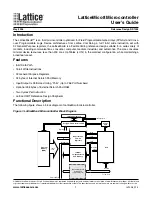
10.3
Data Move Functions
The Data Move functions of the Instruction Set provide basic data move capabilities.
•
Move Data. This function copies data as individual bits, so the new location does not
have to be the same data type.
•
Block Move. This function places constants into seven specified memory locations.
•
Block Clear. This function fills an area of memory with zeros.
•
Shift Register. This function shifts one or more data words or data bits from a
reference location into a specified area of memory. Data already in the area is shifted
out.
•
Communication Request (COMMREQ). This important function allows the CPU to
communicate with intelligent modules in the system, for example, communications
modules. The basic format of the COMMREQ function is shown in this chapter. The
detailed parameters needed to program specific communications tasks are provided in
the documentation for each module.
10.3.1
Data Move Functions Move Data
The Move function copies data as individual bits from one location to another. Because
the data is copied in bit format, the new location does not need to be the same data type as
the original.
When the Move function receives power flow, it copies data from input parameter IN to
output parameter Q as bits. If data is moved from one location in discrete memory to
another, (for example, from %I memory to %T memory), the transition information
associated with the discrete memory elements is updated to indicate whether or not the
Move operation caused any discrete memory elements to change state. Data at the input
parameter does not change unless there is an overlap in the source and destination.
Value to be Moved
OK
Enable
MOVE
INT
IN
Output
Q
Note that if an array of Bit-type data specified in the Q parameter does not include all the
bits in a byte, the transition bits associated with that byte (which are not in the array) are
cleared when the Move function receives power flow.
The input IN can be either a reference for the data to be moved or a constant. If a constant
is specified, then the constant value is placed in the location specified by the output
reference. For example, if a constant value of 4 is specified for IN, then 4 is placed in the
memory location specified by Q. If the length is greater than 1 and a constant is specified,
then the constant is placed in the memory location specified by Q and the locations
following, up to the length specified. Do not allow overlapping of IN and Q parameters.
Instruction Set Reference
GFK-1503E User Manual 147
For public disclosure
Summary of Contents for VersaMax PLC
Page 16: ...Notes 16 GFK 1503E VersaMax PLC User Manual For public disclosure ...
Page 38: ...Notes 38 GFK 1503E VersaMax PLC User Manual For public disclosure ...
Page 50: ...Notes 50 GFK 1503E VersaMax PLC User Manual For public disclosure ...
Page 92: ...Notes 92 GFK 1503E VersaMax PLC User Manual For public disclosure ...
Page 112: ...Notes 112 GFK 1503E VersaMax PLC User Manual For public disclosure ...
Page 224: ...Notes 224 GFK 1503E VersaMax PLC User Manual For public disclosure ...
Page 292: ...Notes 292 GFK 1503E VersaMax PLC User Manual For public disclosure ...
Page 316: ...Notes 316 GFK 1503E VersaMax PLC User Manual For public disclosure ...
Page 317: ......















































